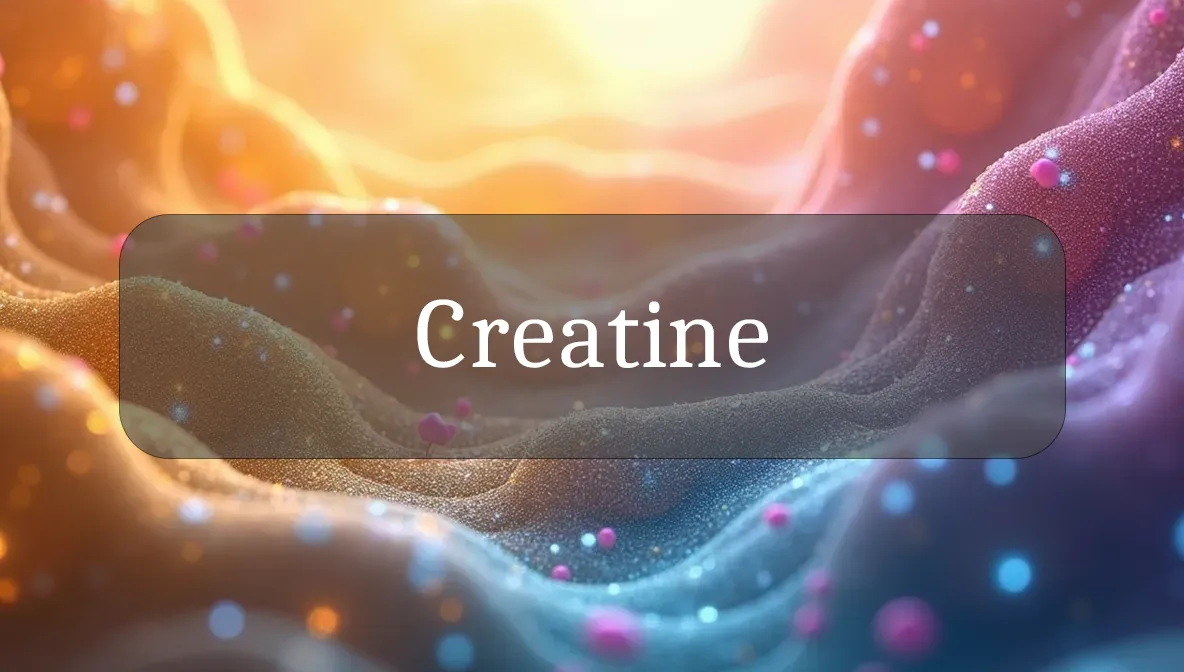Amino Acid Derivative That Boosts Muscle Power and Brain Health
Creatine is like your body’s energy booster, a molecule that fuels your muscles and sharpens your mind. It’s a favorite among athletes but also a key player in daily wellness, supporting strength, stamina, and even cognitive function. Let’s dive into what creatine is, how it benefits your health, and practical ways to harness its power—all in a clear, friendly way to empower your health choices.
Chemical Identity and Type
Creatine is a molecule derived from amino acids, specifically arginine, glycine, and methionine. It’s a naturally occurring compound found in muscle cells, where it’s stored as creatine phosphate, a high-energy molecule that helps produce adenosine triphosphate (ATP), your body’s primary energy currency. Synthesized in the liver, kidneys, and pancreas, creatine is not a protein but a nitrogen-containing compound that supports energy metabolism.
Biological Role and Benefits
Creatine is your body’s energy spark, powering muscles and more. Here’s how it supports your wellness:
- Muscle Performance: Creatine boosts ATP production, fueling short, intense bursts of activity like sprinting or lifting, enhancing strength and endurance.
- Muscle Growth: It promotes muscle cell hydration and protein synthesis, helping build lean muscle mass.
- Brain Function: Creatine supports brain energy needs, improving focus, memory, and cognitive performance, especially under stress.
- Recovery Support: It reduces muscle damage and speeds recovery after intense exercise.
- Energy for Daily Tasks: By supporting ATP, creatine keeps you energized for physical and mental challenges.
By enhancing energy production, creatine boosts your strength, mental clarity, and overall vitality.
Dietary or Natural Sources
Your body makes about 1–2 grams of creatine daily, but you can also get it from food or supplements. Top sources include:
- Animal-Based: Red meat (beef, pork), fish (salmon, tuna), and poultry (chicken, turkey) provide 1–2 grams per pound.
- Dairy: Small amounts in milk and cheese.
- Plant-Based: Minimal in plants, so vegetarians may have lower levels.
- Nutrient Boosters: Arginine (turkey, peanuts), glycine (gelatin, spinach), and methionine (eggs, sesame seeds) support creatine synthesis.
Creatine supplements (e.g., creatine monohydrate, 3–5 grams daily) are popular for boosting levels, especially for athletes or vegetarians. A typical diet provides 1–2 grams daily, but supplements can increase muscle stores significantly.
Signs of Imbalance or Dysfunction
Creatine imbalance is rare since your body regulates it, but low levels or dysfunction may show up as:
- Fatigue or Low Stamina: Reduced energy for exercise or daily tasks due to low creatine stores.
- Muscle Weakness: Difficulty building or maintaining muscle, especially in vegetarians or older adults.
- Cognitive Fog: Poor focus or mental fatigue, as the brain relies on creatine for energy.
- Slow Recovery: Prolonged muscle soreness after workouts.
- Metabolic Issues: Rare genetic disorders (e.g., creatine synthesis deficiencies) can cause developmental delays or muscle problems.
Low levels are common in vegetarians or those with low meat intake, while excess (from over-supplementation) is usually harmless but may strain kidneys in rare cases.
Supporting Optimal Levels or Function
To keep creatine levels high and maintain its benefits, try these practical steps:
- Eat Creatine-Rich Foods: Include red meat, fish, or poultry in meals (e.g., salmon for dinner, chicken for lunch) to boost natural creatine.
- Boost Supporting Nutrients: Eat arginine (nuts, turkey), glycine (spinach, gelatin), and methionine (eggs, fish) to support creatine production.
- Consider Supplements: Take creatine monohydrate (3–5 grams daily, mixed in water or juice) for enhanced muscle and brain benefits. A loading phase (20 grams daily for 5–7 days) is optional but speeds up results.
- Stay Active: Strength training or high-intensity workouts (e.g., sprints, weightlifting) increase creatine demand and effectiveness.
- Hydrate Well: Drink 8–10 cups of water daily, as creatine pulls water into muscles, increasing hydration needs.
- Get Enough Sleep: Aim for 7–9 hours to support muscle recovery and energy metabolism.
- Balance Diet: Pair creatine-rich foods with carbs (e.g., rice, fruit) to enhance muscle uptake.
Safety, Interactions, and Precautions
Creatine is naturally produced and safe for most people, but consider these points:
- Kidney Health: High doses (above 10 grams daily) may stress kidneys in those with pre-existing kidney issues. Consult a doctor if at risk.
- Supplements: Creatine monohydrate is well-studied and safe; side effects like bloating or stomach upset are rare and mild.
- Allergies: Supplements are generally allergen-free, but check labels for additives if sensitive.
- Medications: Creatine may interact with diuretics or kidney-affecting drugs; consult your doctor if on these treatments.
- Hydration: Increased water needs with creatine use can lead to dehydration if not managed.
Fun Fact
Did you know creatine was first discovered in 1832 in beef muscle? Its name comes from the Greek word “kreas,” meaning meat, and it’s been powering athletes and brains ever since!
Citations
- National Institutes of Health. (2023). Creatine and muscle performance. MedlinePlus.
- Mayo Clinic. (2024). Nutrition for athletic performance.
- Cleveland Clinic. (2022). The role of creatine in energy metabolism.
- World Health Organization. (2020). Protein and amino acid requirements in human nutrition.
- USDA FoodData Central. (2023). Nutrient profiles for creatine-rich foods.

